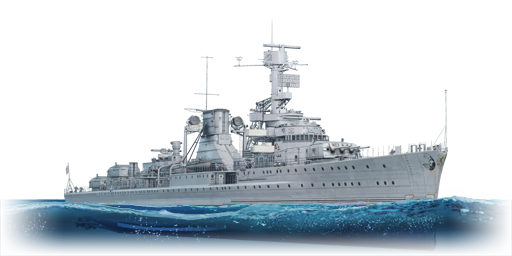The Leipzig was the first ship of the Leipzig-class light cruisers, built for the Kriegsmarine in the 1930s. She was laid down in 1928 and commissioned on 8th October 1931. The Leipzig when built was armed with nine 15 cm SK C/25 cannons in three triple turrets with two located aft and one on bow of the ship. Secondary armament consisted two 8.8 cm/76 SK C/32 guns for anti-aircraft protection. The ship was also armed with four triple torpedo tubes carrying 24 torpedoes in total. These torpedo tubes were removed in a 1941 refit of the ship. The ship served in Spanish Civil War intervention patrols without major incident. After the outbreak of WWII, she laid minefields in the North Sea, where she was also torpedoed by British submarine HMS Salmon on 13th December 1939 together with her sister ship Nürnberg. After repairs in drydock and a refit, Leipzig became training ship before returning to service in late 1940. In June 1941, together with light cruiser Emden she supported German troops during Operation Barbarossa. In 1942, she again became flagship of the Training fleet until March 1943 when she underwent another refit and returned to active duty again in mid-September 1944 performing escorts in the Baltic Sea. On 14th October 1944, she departed Gotenhafen bound for Swinemünde, she collided in heavy fog with heavy cruiser Prinz Eugen which at the time of collision was steaming at 20 knots (37 km/h) and nearly cut her in half. Number 3 engine room was destroyed, and a second engine room flooded. 39 sailors lost their lives or were wounded in the accident. The following day, she was towed back to Gotenhafen where emergency repairs to keep her afloat were conducted. Due to the bad military situation of Germany, her repair was deemed unreasonable. She provided fire support to defend German forces in March 1945 against the advancing Red Army. On 24th March, she left for her final voyage from Hela, laden with refugees and steaming only at 6 knots (11 km/h) towards Denmark which she reached on 29th April. After the war, she was used as barracks ship until scuttled in 1946 due to her bad condition.
Leipzig was introduced in Update 1.97 "Viking Fury". The playstyle of Leipzig is very similar to her sister Nürnberg or K-class cruiser Köln. The main difference between her and Nürnberg is the inability to carry torpedoes. The Leipzig possesses impressive firepower as her main guns can fire up to 12 rounds per minute, however, the ship itself and the magazines in particular are very lightly protected by 30 mm belt armour and are located above the waterline, making them extremely vulnerable to fatal explosions. The long-range anti-aircraft suite consists of three pairs of 8.8 cm cannons with HE-TF shells, while close-range protection is made up of four 3.7 cm SK C/30 dual mounted cannons and two 2 cm/65 Flakvierling 38 quadruple cannons as well as seven 2 cm/65 C/30 single mounted cannons. The Leipzig is capable of dealing heavy damage to enemy ships, but caution is needed as the ship cannot sustain enemy fire for long.














